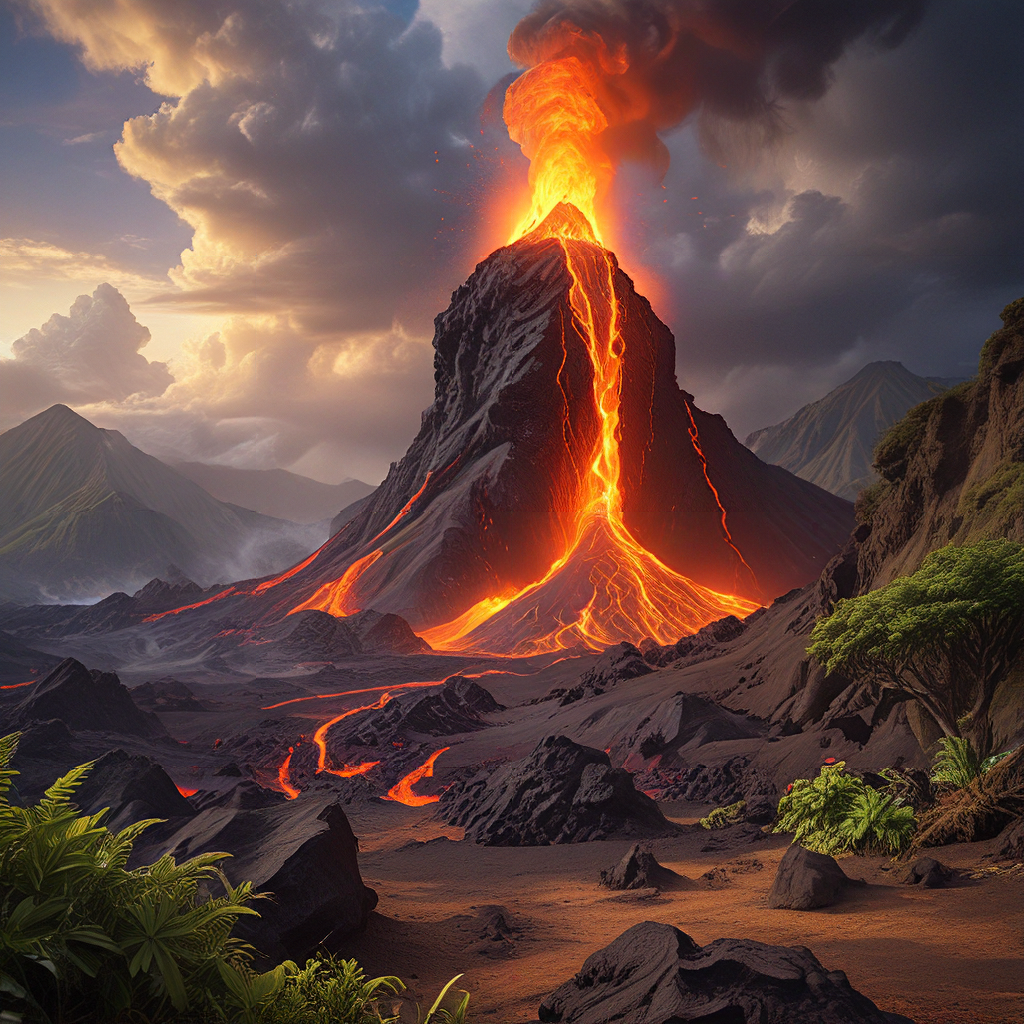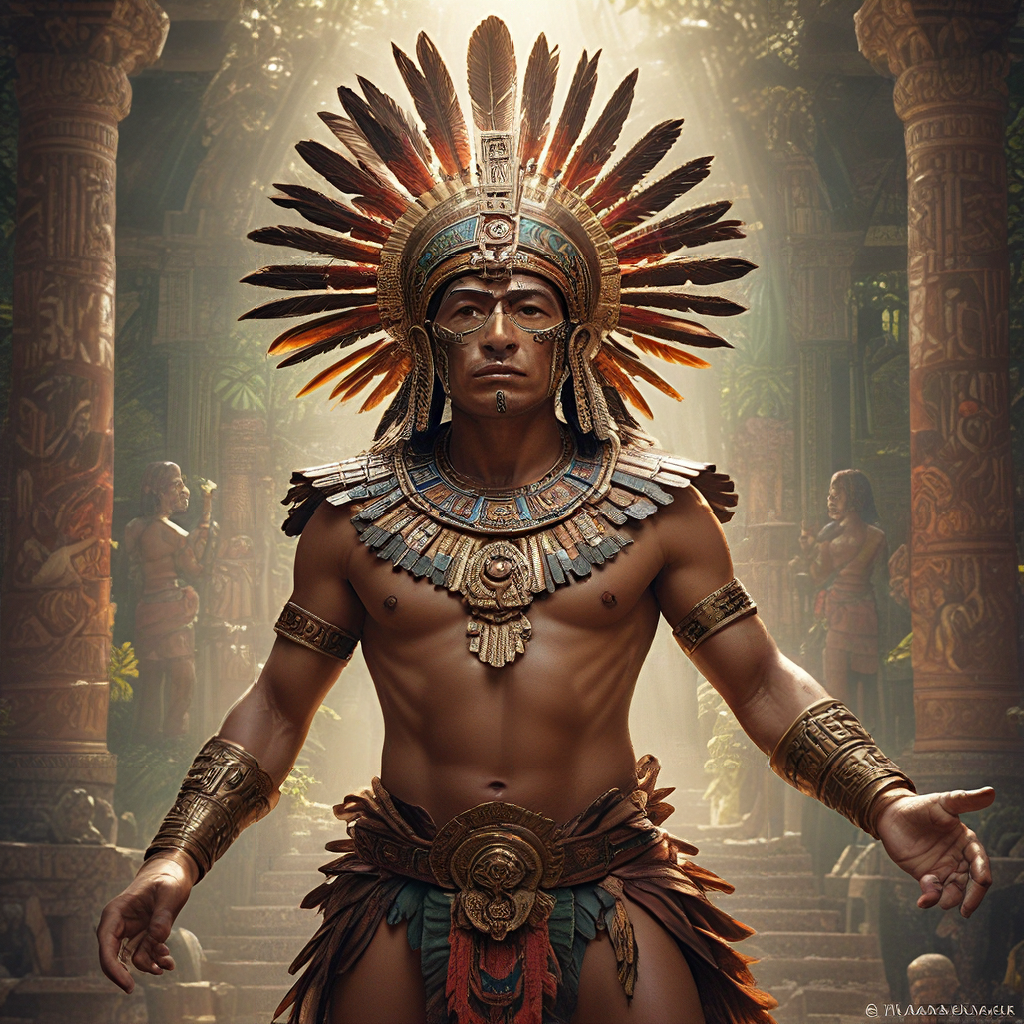Hawaiian Volcano Myths: Creatures From the Fire
Pele, the Goddess of Fire and Volcanoes
In the heart of the Pacific Ocean, a chain of volcanic islands rises from the sea, each a testament to the fiery power of Pele, the Hawaiian goddess of fire and volcanoes. She is a central figure in Hawaiian mythology, a powerful deity who embodies the raw, unpredictable force of nature. Pele's presence is felt throughout the islands, from the molten lava flows that shape the landscape to the stories that have been passed down for generations.
Pele is not just a goddess; she is a force of nature, a powerful entity that commands respect and awe. Her fiery spirit is entwined with the very essence of the islands, making her a potent symbol of both creation and destruction. Hawaiians believe that Pele's movements are responsible for volcanic eruptions, earthquakes, and other natural phenomena. Her power is not something to be trifled with, and her wrath is feared as much as her generosity.
Legends tell of her fiery temper and her ability to manipulate volcanic activity. She is often depicted as a beautiful woman with fiery red hair, her eyes blazing with the power of molten lava. Though she may appear gentle and alluring, Pele is a force to be reckoned with. Her anger can be devastating, unleashing fiery destruction upon those who disrespect her or her domain.
The Origin and Significance of Pele
Pele is not just a mythological figure; she is a symbol of creation and connection to the ancestral past. The story of her origins, similar to many creation myths, helps explain the fundamental workings of the world and the Hawaiian people's relationship with their environment. The story of Pele's creation speaks to the unique and powerful connection between the Hawaiian people and their volcanoes.
According to Hawaiian legend, Pele was born on the volcanic island of Tahiti, a place of immense fire and power. She is said to be the daughter of Haumea, the goddess of fertility and creation, and Kane Milohai, the god of the sea. This lineage indicates a deep connection between Pele's fiery nature and the forces of creation and the ocean, reflecting the intricate balance of nature in the Hawaiian islands.
Pele's journey to Hawaii, a journey filled with turmoil and conflict, highlights the constant struggle between creation and destruction, a theme central to Hawaiian mythology and worldview. The volcanoes themselves are viewed as living entities, manifestations of Pele's spirit. They are not just geological formations but sacred sites, places of immense power and spiritual significance.
Her story tells us that the volcanoes are not just geological formations, but living entities, manifestations of Pele's spirit. They are sacred sites, places of immense power and spiritual significance. This inherent connection to the land and a powerful deity is a core element of Hawaiian identity and spirituality.
Volcanoes as Sacred Sites
The Hawaiian islands are more than just collections of land masses; they are sacred spaces, imbued with the spirit of Pele and other gods. Volcanoes, particularly Kilauea and Mauna Loa on the Big Island, are revered as the embodiment of Pele's power. They are not just sources of danger but also places of immense spiritual significance, where Hawaiians seek guidance, healing, and connection with the divine.
These volcanoes, particularly Kilauea, are not just sources of danger but also places of immense spiritual significance. They are seen as doorways to the spirit world, where ancestors reside and where humans can seek guidance, healing, and connection with the divine. It is no wonder that many traditional Hawaiian practices are centered around these sacred sites.
The act of offering gifts, or "hoʻokupu," to Pele is a vital part of maintaining harmony with the goddess and the volcanoes. Gifts are meant to appease Pele and ensure the safety of the people and the land. These offerings typically consist of food, flowers, or other sacred objects, left at the edges of the volcanic craters or within the lava flows.
The Myth of Pele’s Journey to Hawaii
Pele's journey to Hawaii is a story filled with drama, conflict, and ultimately, the establishment of her enduring presence on the islands. The tale unfolds with Pele fleeing Tahiti, escaping the wrath of her sister, Hiʻiaka, a powerful sorceress. Her flight across the Pacific Ocean, chasing the flames of her volcanic fire, is not merely a journey of displacement but a quest for a new home, a new place to embody her fiery essence.
On her journey, Pele encounters resistance, obstacles, and challenges that mirror the tumultuous nature of the volcanic forces she represents. She lands on Kauai, but her fiery power causes devastation, driving her further eastward. Eventually, she reaches the Big Island, specifically the Kilauea volcano, finding a place where she can unleash her power and settle, establishing her domain and shaping the landscape with her volcanic fire.
Her arrival in the Big Island signifies a powerful act of creation and transformation. The story of Pele's journey is not just about a mythical figure but about the formation of the islands themselves, the volcanic forces that created the land and sculpted the very essence of the Hawaiian archipelago. This journey is a captivating allegory for the constant struggle between creation and destruction, a duality that is crucial to understanding the Hawaiian worldview.
Pele’s Relationship with Humans
While Pele's power is immense and her temperament volatile, her relationship with humans is complex and interwoven with acts of both destruction and generosity. She is both feared and revered, her fiery nature demanding respect and understanding. She is not just a deity to be worshipped but a force of nature that must be acknowledged and appeased.
Humans who disrespect Pele or her domain often face her wrath, encountering volcanic eruptions, earthquakes, and other natural disasters. On the other hand, those who show reverence and offer gifts may be rewarded with blessings, such as fertile land, abundant harvests, and protection from harm. This balance between fear and respect highlights the delicate relationship that humans must cultivate with the forces of nature.
The offerings given to Pele, a vital aspect of this relationship, are meant to appease her, seek her favor, and ensure the safety and well-being of the people and the land. These offerings are not merely a superstitious act but a symbolic gesture of acknowledgment and respect for the power of the natural world and its influence on human lives. Though Pele's power is immense and her temperament volatile, she is not a cruel deity; she is simply a natural force that demands respect and understanding.
The Significance of Offerings
Understanding Pele’s nature is crucial to understanding the offerings made to her. These offerings, called “hoʻokupu,” are not mere appeasements but acts of respect and balance in the relationship with the goddess. They are vital for maintaining harmony with the volcano’s power and ensuring the safety of the people and the land.
The offerings are a symbolic gesture of acknowledgment and respect for the power of the natural world and its influence on human lives. These offerings are not just a superstitious act, but a way to show understanding of the delicate relationship between humans and the powerful forces of nature.
The type of offering varies, reflecting the specific intention of the giver. Flowers, food, and other precious objects are placed at the edge of volcanic craters or within lava flows, a gesture of respect for Pele’s domain. The act of offering itself is a ritual, a way to show humility and acknowledge the goddess’s power.
Theories on the Origins of Pele Mythology
The story of Pele is deeply rooted in Polynesian mythology and reflects the powerful connection between people and the environment. Several theories attempt to explain the origins and evolution of the Pele myth. One theory suggests that the myth is a way to explain the volcanic activity that is so prevalent in the Hawaiian islands.
Another theory suggests that the Pele myth evolved from earlier Polynesian creation myths. Many Polynesian cultures have stories about fire goddesses, suggesting a common origin for these myths. However, the specific details of Pele’s story, including her journey to Hawaii and her relationship with the volcanoes, are unique to Hawaiian mythology.
These stories, passed down through generations, have helped to shape Hawaiian identity and culture. They continue to serve as a reminder of the power of nature and the need for respect and understanding.
The Role of Volcanoes in Hawaiian Culture
Volcanoes are more than just geological formations in Hawaiian culture; they are the very heart of the islands. They are viewed as sacred spaces, embodying the power of Pele and other deities. Each island has its own unique volcanic history, with names and stories reflecting the relationship between humans and the volcanoes.
The volcanic landscape itself is a testament to Pele’s power, shaping the islands and providing fertile soil for agriculture. Volcanoes are seen as sources of life, providing sustenance and resources for the Hawaiian people. The volcanic landscape is not just a physical environment, but a spiritual one, filled with stories and legends that connect the Hawaiian people to their ancestors and the natural world.
Volcanoes are also seen as sources of knowledge and wisdom. They remind people of the cyclical nature of life, death, and rebirth, a powerful metaphor for the ever-changing nature of the world. The volcanic eruptions, which are seen as expressions of Pele’s power, are also a reminder of the need for respect and adaptability in the face of nature’s power.
The Influence of Pele on Hawaiian Traditions
The influence of Pele on Hawaiian traditions is profound and multifaceted. She is a central figure in many Hawaiian chants, dances, and songs, her legend and story woven into the fabric of Hawaiian culture. The story of Pele is a powerful reminder of the importance of respecting the power of nature and living in harmony with the environment.
Some traditional Hawaiian dances, such as the “hula,” are believed to have been inspired by Pele’s volcanic fire. These dances are not just forms of entertainment but rituals that connect people to the goddess and her power. The chants and songs associated with Pele often tell stories of her journeys, her battles, and her relationship with humans.
These traditions help to preserve the memory of Pele and her story, ensuring that her legend lives on through generations. Pele's influence is evident in many aspects of Hawaiian life, and her stories are a valuable part of understanding Hawaiian identity and culture.
The Enduring Legacy of the Mythical Creatures
The story of Pele, the goddess of fire and volcanoes, is more than just a myth; it is a living tradition that continues to shape the lives of the Hawaiian people. The volcanoes, once feared as the embodiment of Pele’s power, are now revered as sacred sites, reminders of the delicate balance between creation and destruction, life and death.
The story of Pele teaches us about the importance of respect for nature, the need to understand the power of the natural world, and the importance of living in harmony with the environment. This enduring legacy of Pele, the Hawaiian goddess of volcanoes, is a testament to the power of storytelling and the importance of connecting with the natural world.
Frequently Asked Questions
What is the story of Pele?
Pele is the Hawaiian goddess of fire and volcanoes. Her legend tells the story of her escape from Tahiti, her journey to Hawaii, and the establishment of her domain at the Kilauea volcano.
Why are volcanoes considered sacred in Hawaii?
Volcanoes are seen as manifestations of Pele’s power, making them sacred sites where Hawaiians seek guidance, healing, and connection with the divine.
What are offerings to Pele?
Offerings, called “hoʻokupu,” are a way to appease Pele and ensure the safety of the people and the land. Traditional offerings include flowers, food, and other precious objects.
What is the significance of the Pele myth?
The Pele myth teaches about the power of nature, the importance of respecting the environment, and the need for harmony between humans and the natural world.
What is the relationship between Pele and the Hawaiian people?
Pele is both feared and revered by the Hawaiian people. Her fiery nature demands respect, and those who disrespect her or her domain may face her wrath.
How has the Pele myth influenced Hawaiian culture?
Pele’s story is central to many Hawaiian traditions, including chants, dances, and songs. The myth helps to preserve the memory of the goddess and her power, ensuring she remains a vital part of Hawaiian identity and culture.


